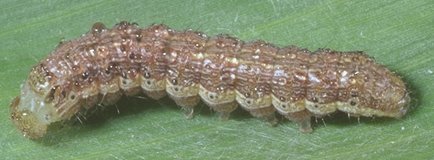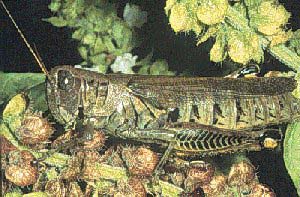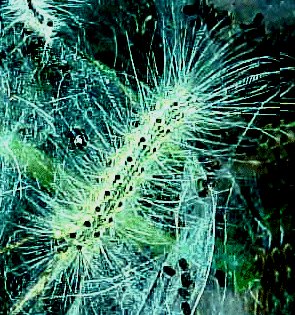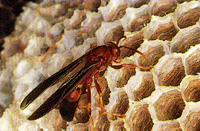

SORGHUM WEBWORM and CORN EARWORMS feeding on grain sorghum heads;
GRASSHOPPERS, HORNWORMS, and BUDWORMS are late season tobacco feeders;
GREEN STINK BUGS feeding on soybean pods;
check late-planted corn fields for damaging CORN BORER INFESTATIONS;
CRICKETS and other ACCIDENTAL INVADERS along foundations;
FRUIT FLIES in fruits and vegetables


After this issue, the Kentucky Pest News will be published on an alternate week basis. Weekly issues will return in the spring.


 Heat and dry conditions continued throughout KY during the week of August 20. No new cases of the disease were reported during this period.
Heat and dry conditions continued throughout KY during the week of August 20. No new cases of the disease were reported during this period.
Unfavorable environmental conditions for development and spread of blue mold will prevail during the week of August 27. Late-set crops that have yet to be topped face a minor risk as temperatures decrease toward the end of the week. However, the majority of tobacco in KY has been topped and harvest is well under way, further reducing the threat posed by blue mold. Growers should continue to scout their crops for the presence of blue mold and be prepared to make applications of fungicides if disease-favorable conditions prevail and if the tobacco has not been topped. Refer to ID-160, the 2007 KY Tobacco Production Guide, for recommended disease-control products.
Please be on the lookout for blue mold and let me know if the disease is found in your area.
For the latest blue mold status and other tobacco disease information, check the KY Blue Mold Warning System online.
![]() http://www.uky.edu/Agriculture/kpn/kyblue/kyblue.htm
http://www.uky.edu/Agriculture/kpn/kyblue/kyblue.htm

For more information about tobacco pests, visit "Insect Management Recommendations".
 The 2007 growing season is drawing to a close, and our growers are working hard at getting their crops into the barn. In terms of disease, we've had a pretty light year compared to previous seasons - black shank was problematic in many parts of the state and we saw more tomato spotted wilt and Fusarium wilt than normal. However, our old nemesis, blue mold, and target spot have been relatively mild. There's no doubt that dry weather has played a part in keeping these problems in check. Given the severity of the drought and heat this summer, it was good that the majority of our producers did not have to deal with the headaches that a serious epidemic of disease can bring.
The 2007 growing season is drawing to a close, and our growers are working hard at getting their crops into the barn. In terms of disease, we've had a pretty light year compared to previous seasons - black shank was problematic in many parts of the state and we saw more tomato spotted wilt and Fusarium wilt than normal. However, our old nemesis, blue mold, and target spot have been relatively mild. There's no doubt that dry weather has played a part in keeping these problems in check. Given the severity of the drought and heat this summer, it was good that the majority of our producers did not have to deal with the headaches that a serious epidemic of disease can bring.
What will 2008 bring us in terms of disease? As we've seen so many times, there's no way to tell, and so much depends upon the climate when dealing with diseases like blue mold and target spot. We do know, however, that some problems will show up again and again once certain pathogens, such as Pythium, Rhizoctonia solani, Fusarium oxysporum and Phytophthora nicotianae, have become established in a transplant system or the field.
We need to begin thinking about diseases like Pythium root rot, target spot, black shank and Fusarium wilt and how to go about getting a head start on managing them in 2008. A critical step is to institute good sanitary practices on the farm. Many diseases that we see in the float system and field survive between crops on equipment and plant residues. Greenhouses and outdoor float beds should be cleaned thoroughly and sanitized in the fall to reduce overwintering populations of pathogens. Plant debris and trash should be buried or burned. Styrofoam trays should be cleaned carefully, sanitized as recommended (or destroyed), and stored properly before winter sets in. In the field, especially where black shank was a problem, all crop debris needs to be turned in as quickly as possible after harvest. The black shank pathogen (as well as Rhizoctonia and Pythium) survives very well on crop residues, and stalks left in the field can be a source of inoculum that can lead to outbreaks of disease in 2008. By plowing crop residues under in the fall, there will be more time for soil microbes to break down plant matter. This in turn will help reduce pathogen survival over the winter, and the effect will be greater than waiting until next spring to incorporate crop residue.
It's also time to think about crop rotation. One of the best practices that we can recommend for preventing or suppressing diseases like black shank and Fusarium wilt is rotation to a non-host crop. Even though we are many months from planting, growers need to start the planning process and make decisions on field choice and potential rotation crops. Fall is also a great time to think about variety selection and to begin planning for the production of transplants. We will have a new variety, 'KT 206', available in 2008 that brings improved resistance to black shank (Race 0 and Race 1) along with moderate resistance to blue mold. This variety has performed well in field trials over the past couple of years, and will be a good choice for growers with a history of black shank on their farms.
For the latest blue mold status and other tobacco disease information, check the KY Blue Mold Warning System online.
![]() http://www.uky.edu/Agriculture/kpn/kyblue/kyblue.htm
http://www.uky.edu/Agriculture/kpn/kyblue/kyblue.htm


 Certainly the big soybean question in our part of the country is "Will we get any rain?" If we do not, for many of us, all other questions are moot. However, if you feel that you have a chance at a soybean crop, you still have to manage your insect or mite problems. Dry weather poses some different challenges in that regard.
Certainly the big soybean question in our part of the country is "Will we get any rain?" If we do not, for many of us, all other questions are moot. However, if you feel that you have a chance at a soybean crop, you still have to manage your insect or mite problems. Dry weather poses some different challenges in that regard.
I am in fact, surprised that we have not seen more problems with mites. Nevertheless, at this writing I have not received any reports of outbreak situations. Certainly, the mites are around, so you should keep a look out for the traditional "bronzing" of the leaves which they tend to cause.
One pest I have seen an abundance of is the adult stage (moth) of the corn earworm, often called the soybean podworm when in soybeans. This hot dry weather may increase the risk of this insect in soybean fields. Lots of corn is being cut early for silage, and or drying down much earlier and faster than in average years. This causes corn earworm moths to look for alterative places to lay their eggs. Soybean is a suitable and likely host. Additionally, this insect is believed to be a more problematic pest in fields where the soybean canopy has not closed. We have many fields in this condition at present.
This insect can be particularly damaging to soybean because it feeds directly on the pods. Because of this, it is easy to overlook the damage unless pods are checked for signs of feeding. You will see very little leaf feeding by this insect. Additionally, damage impacts directly on the yield that is already made. Soybean podworm consumes individual beans, allows entry of disease causing organisms into the pods, and may feed on the petiole resulting in pod abortion or stoppage of nutrient flow in to the pod.
It does not take many of these insects to cause an economic loss. In Kentucky our threshold is 2 worms per row foot. But the real importance is in detecting the pest; most podworm losses are the result of not detecting their presence. You must scout your beans and look closely at the pods for this insect and pod damage. If an economic problem develops you may find insecticides for use against this pest in ENT- 13, Insecticides for use in Soybean. You can obtain a copy of this publication at any county Extension office or on the web at: http://www.uky.edu/Ag/PAT/recs/rechome.htm
For more information about soybean pests, visit
"Insect Management Recommendations".


 Several insects feed on late summer seedings of alfalfa and forage grasses, often without harm. However, if enough are present, there can be significant stand loss. The most common culprits are fall armyworms and grasshoppers but crickets and other insects can be there, too. Fall armyworms feed on corn, grasses, and a range of other crops. They can be active until a killing frost. Several beetle species, including the spotted cucumber beetle, feed on alfalfa seedlings. Regular inspection of new seedings will allow early detection and assessment of feeding damage, and treatment if necessary.
Several insects feed on late summer seedings of alfalfa and forage grasses, often without harm. However, if enough are present, there can be significant stand loss. The most common culprits are fall armyworms and grasshoppers but crickets and other insects can be there, too. Fall armyworms feed on corn, grasses, and a range of other crops. They can be active until a killing frost. Several beetle species, including the spotted cucumber beetle, feed on alfalfa seedlings. Regular inspection of new seedings will allow early detection and assessment of feeding damage, and treatment if necessary.
Fall armyworm infestations tend to be clumped and intense because each female can lay several hundred eggs in a mass. The small larvae move out from these focus sites as they grow and consume all of the nearby plants. Look for roughly circular areas of missing plants. Examine the soil under surface debris for the striped larvae. If caught early, spot treatments can be sufficient to deal with the problem.
Grasshoppers and crickets can chew off small seedlings. Damage may appear at the edges of fields and expand inwards. These insects will move readily so feeding should be more diffuse over an area.
Evaluate injury carefully. Low rates and spot treatments may be all that is needed to deal with pest activity. See ENT-17 for control options.


 Sour bunch rots involve secondary microbes that decay ripening grapes on the vines, usually in wet weather. Dry weather this season has helped to reduce the amount of sour bunch rots in most Kentucky grapes except those watered by overhead sprinklers. Ripening berries with injuries are susceptible to invasion by many microorganisms that can enter through insect or bird-feeding sites, mechanical cracks, or lesions caused by diseases. These organisms can cause extensive damage because the decay might progress well beyond the initial invasion site. Sour bunch rots are caused by a mix of various fungi, yeasts, acetic acid bacteria, fruit fly larvae, and other organisms.
Sour bunch rots involve secondary microbes that decay ripening grapes on the vines, usually in wet weather. Dry weather this season has helped to reduce the amount of sour bunch rots in most Kentucky grapes except those watered by overhead sprinklers. Ripening berries with injuries are susceptible to invasion by many microorganisms that can enter through insect or bird-feeding sites, mechanical cracks, or lesions caused by diseases. These organisms can cause extensive damage because the decay might progress well beyond the initial invasion site. Sour bunch rots are caused by a mix of various fungi, yeasts, acetic acid bacteria, fruit fly larvae, and other organisms.
Symptoms and Disease Cycle. Affected berries have a soft, wet rot and smell like vinegar which comes from acetic acid produced by Acetobacter bacteria. Juice from the rotting berries can drip onto other berries and serve as a food base for the growth of additional rot fungi. By the time sour rot has developed, it is often impossible to determine its primary cause. There are many other microbes that invade wounds and decay fruits. These secondary invaders and sour rot organisms are present on most plant surfaces and on debris in the soil. Sour bunch rots may be initiated by the decay of one or two injured berries in a cluster. The bacteria can be carried to rotting clusters by fruit flies that are attracted to these clusters or they can be distributed by wind, rain, or other insects. Berry decay can begin as soon as berries become wounded. Sour bunch rot is favored by rainy weather, especially when grapes are near harvest.
Sour Rot Disease Management. It is important to manage sour rots because rotting berries are generally not suitable for making wine due to the likelihood of causing odd or distasteful flavors.


 Fall webworms are covered by pale green or yellow hairs and have rows of black spots along their backs. Groups of these caterpillars can be found in webbing at the end of branches on American elm, maples, hickory, sweetgum, and other deciduous plants. Usually, the infestation is limited to a branch or two on a plant and the impact is aesthetic rather than a plant health threat. Removal and destruction of the web and caterpillars is an effective control measure.
Fall webworms are covered by pale green or yellow hairs and have rows of black spots along their backs. Groups of these caterpillars can be found in webbing at the end of branches on American elm, maples, hickory, sweetgum, and other deciduous plants. Usually, the infestation is limited to a branch or two on a plant and the impact is aesthetic rather than a plant health threat. Removal and destruction of the web and caterpillars is an effective control measure.


 Wasp stings are a serious health threat to humans and animals. Many people in the United States die each year from allergic reactions to the venom of these insects. Paper wasps, hornets and yellowjackets are more dangerous and unpredictable than honeybees. Workers foraging away from the nest are seldom aggressive, but nests should be eliminated with great care and in a specific manner. "Folk" remedies such as dousing nests with gasoline or a garden hose seldom work and can result in multiple stings.
Wasp stings are a serious health threat to humans and animals. Many people in the United States die each year from allergic reactions to the venom of these insects. Paper wasps, hornets and yellowjackets are more dangerous and unpredictable than honeybees. Workers foraging away from the nest are seldom aggressive, but nests should be eliminated with great care and in a specific manner. "Folk" remedies such as dousing nests with gasoline or a garden hose seldom work and can result in multiple stings.
Paper Wasps -- Paper wasps (as well as hornets and yellowjackets) construct nests of a paper-like material containing finely chewed wood fragments and salivary secretions. Paper wasps typically build their umbrella-shaped nests in protected locations, such as under eaves, gutters and ledges or in attics and outbuildings. Nests also may be located behind shutters, or inside exterior light fixtures, gas grills and mailboxes. Most paper wasps are brownish or rust-colored, although one increasingly common variety, the European paper wasp, has yellow and black markings much like a yellowjacket. Paper wasps have a "waist" that is very thin, however, which distinguishes them from hornets and yellowjackets.
Paper wasps are not very aggressive, but stings can occur when householders inadvertently disturb nests that are hidden. If the nest is accessible, it can be eliminated rather easily with a wasp and hornet spray sold at most retail stores. One advantage of these formulations is that they can be sprayed as far as 20 feet. Although it's best to treat all wasp nests at night, paper wasps can be eliminated during the daytime provided you do not stand directly below the nest during treatment. Most wasp aerosol sprays cause insects to drop instantly. Standing directly under a nest increases the risk of being stung. After treatment, wait a day to ensure that the colony is destroyed; then scrape or knock down the nest.
Hornets -- Hornets are far more difficult and dangerous to control than paper wasps. The nests resemble a large, gray, bloated football, which typically is attached to a tree, bush or side of a building. Oftentimes the nest is concealed among branches, especially in densely canopied trees such as Bradford pear. Hornet nests may contain thousands of wasps that are extremely aggressive when disturbed. The nests often are located out of reach and elimination is best accomplished by a professional pest control firm.
Treat hornet nests at night when most insects are within the nest and less active (follow night treatment precautions discussed below for yellowjackets). A full wasp suit, sealed at the wrists, ankles and collar, is recommended. Apply an aerosol-type wasp and hornet spray or dust formulation (e.g., Sevin, Drione, DeltaDust) directly into the nest opening. Hornet nests generally have a single opening, usually toward the bottom, where the wasps enter and exit. It is crucial that the paper envelope of the nest not be broken during treatment or the irritated wasps will scatter in all directions, causing even greater problems. Following treatment, wait at least 2-3 days before removing the nest to ensure that all of the wasps are killed. If hornets continue to be seen, the application may need to be repeated.
If the nest is located away from frequently used areas, another option is to wait and do nothing. In Kentucky, wasp, hornet, yellowjacket, and bumblebee colonies die off naturally after the weather turns cold, and the paper carton disintegrates over the winter months.
Yellowjackets -- Yellowjackets are probably the most dangerous stinging insects in the United States. They tend to be unpredictable and usually sting if the nest is disturbed. Yellowjacket nests are often located underground in old animal burrows (e.g., chipmunks), or beneath rocks or landscape timbers. They also build nests in walls, attics, crawlspaces, and behind exterior siding of buildings.
If the nest can be located, it often can be eliminated by applying an aerosol-type wasp and hornet spray into the opening. Insecticide dust formulations containing Sevin (sold in lawn and garden shops), DeltaDust, or Drione, are especially effective but require a hand duster to dispense several puffs of the dust into the nest opening. In lieu of a commercial duster, a workable alternative is to use a dry, empty liquid detergent bottle filled with an inch or so of dust. A few pebbles or marbles added to the bottom prevents the dust from caking, and the bottle should be shaken before dispensing. (Remember to dispose of the bottle after use, or store it away from children and pets). Dusts tend to be more effective than aerosols when the nest itself is located some distance from the entrance hole - as often occurs when yellowjackets construct nests behind exterior siding or deep within abandoned animal burrows. Insecticide dust blown into the opening penetrates farther than sprays, and the workers transport it throughout the nest.
Ideally, treatment should be performed at night, when most of the yellowjackets are in the nest and less active. Pinpoint the nest opening during the daytime, so you will remember where to direct your treatment after dark. Approach the nest slowly and do not shine the beam of your flashlight directly into the nest entrance as this may startle the wasps and cause them to fly toward the light. Instead, cast the beam to the side to illuminate the nest indirectly. If possible, place the light on the ground rather than in your hand.
When contemplating extermination of a yellowjacket or hornet nest, clients should be informed that they are entering a DANGER ZONE - there is no pest control scenario more frightening than a 'blown' wasp or hornet treatment. It is often prudent to refer homeowners to a professional, especially when access to the nest requires a ladder or is difficult.
Wasp, hornet and yellowjacket stings can be life threatening to persons who are allergic to the venom. People who develop hives, dizziness, breathing or swallowing difficulty, wheezing, or similar symptoms of allergic reaction should seek medical attention immediately. Itching, pain, and localized swelling can be reduced with antihistamines and an ice pack.

According to a recent news story, Kentucky wildlife officials suspect hemorrhagic disease (HD), caused by a virus, has caused the deaths of "numerous" white-tailed" deer in portions of western Kentucky including Breckinridge, Christian, Daviess, Hopkins, Logan, McLean, Muhlenberg, Ohio, Simpson, and Webster counties. HD is transmitted by blood-feeding gnats (Culicoides) called no-see-ums (about 1/10 inch long). Problems with HD occur when weather conditions favor very large populations of the gnats.
Batches of eggs are laid and the small worm-like larvae develop in wet to moist habitats including edges of standing pools, saturated soil, and moist decaying vegetation. Development takes only a few days during warm weather and it is impossible to find and treat breeding sites. Most adults stay within a few hundred yards of where they developed as larvae. The tiny no-see-um adults mostly feed around sunset and sunrise. Most live for 10 to 20 days and take several blood meals during that time.


Agronomic samples over the past week included sudden death syndrome of soybean; and black shank on tobacco.
On fruit and vegetable samples we have diagnosed cedar-apple rust on apple; fire blight on pear; bacterial wilt on pumpkin; Verticillium wilt on eggplant; and Septoria leaf spot and Fusarium wilt on tomato.
On ornamentals and turf we have seen rust (Coleopsporium) on aster; Pythium root rot and iron deficiency on chrysanthemum; black root rot on holly; tip blight on pine; Pythium root rot on bentgrass; and southern blight on mixed turf.


August 17-24, 2007
UKREC-Princeton, KY
| Black Cutworm
| 61
| True Armyworm
| 39
| Corn Earworm
| 309
| European Corn Borer
| 0
| Southwestern Corn Borer
| 22
| Fall armyworm
| 4
| | |
Jackson, TN
| Black Cutworm
| 30
| True Armyworm
| 19
| Corn Earworm
| 0
| European Corn Borer
| 0
| Southwestern Corn Borer
| 10
| Fall armyworm
| 0
| | |
Milan, TN
| Black Cutworm
| 20
| True Armyworm
| 40
| Corn Earworm
| 0
| European Corn Borer
| 0
| Southwestern Corn Borer
| 4
| Fall armyworm
| 0
| | |
Lexington, KY
| Black Cutworm
| 210
| True Armyworm
| 345
| Corn Earworm
| 674
| European Corn Borer
| 4
| Southwestern Corn Borer
| 2
| Fall armyworm
| 3
| | |
This season insect trap counts will be provided for locations in Kentucky and Tennessee.
View trap counts for past seasons and the entire 2007 season at -
http://www.uky.edu/Ag/IPMPrinceton/Counts/2006trapsfp.htm
View trap counts for Fulton County, Kentucky at -
http://ces.ca.uky.edu/fulton/anr/
For information on trap counts in southern Illinois visit the Hines Report at -
http://www.ipm.uiuc.edu/pubs/hines_report/comments.html
The Hines Report is posted weekly by Ron Hines, Senior Research Specialist, at the
University of Illinois Dixon Springs Agricultural Center.
NOTE: Trade names are used to simplify the information presented in this newsletter. No endorsement by the Cooperative Extension Service is intended, nor is criticism implied of similar products that are not named.
Lee Townsend
Extension Entomologist